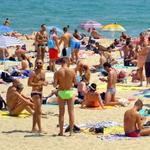Kevin & Antonio
Things To Do

Barceloneta Beach
La Barceloneta is known for its lively atmosphere on both the sand (vendors walk around selling everything from mojitos to on-the-spot massages) and the beachfront promenade (there are cafes and bars situated on the beach throughout). The beach features loads of amenities on-site including bathrooms, showers, changing rooms, umbrellas, lounge chairs, sports courts such as volleyball and beach tennis and more. You can also take a picture with the iconic W Hotel!
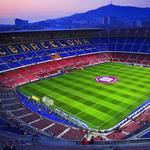
Camp Nou
Camp Nou is the football stadium where FC Barcelona plays! It opened in 1957 and has been the home stadium of FC Barcelona since its completion. With a seating capacity of 99,354, it is the largest stadium in Spain and Europe, and the fourth largest association football stadium in the world in capacity. Click the link to look for games as well as tours!
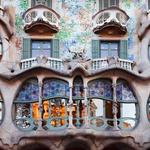
Casa Batlló
In 2005, Casa Batlló became an UNESCO World Heritage Site among the other Works of Antoni Gaudí, and is visited by people from around the world. The ground floor, in particular, has unusual tracery, irregular oval windows and flowing sculpted stone work. There are few straight lines, and much of the façade is decorated with a colorful mosaic made of broken ceramic tiles . The roof is arched and was likened to the back of a dragon or dinosaur. It has been said that the house represents the lance of Saint George (patron saint of Catalonia and Gaudí's home), which has been plunged into the back of the dragon. Buy tickets for a tour with the link below.
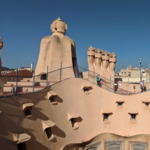
Casa Milà
Casa Milà, popularly known as La Pedrera or "The stone quarry", a reference to its unconventional rough-hewn appearance, is a modernist building in Barcelona, Catalonia, Spain. It was the last private residence designed by architect Antoni Gaudí and was built between 1906 and 1912. It is also a UNESCO World Heritage Site! It is down the street from Casa Batlló and tour tickets can be bought online as well.
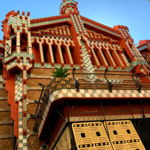
Casa Vicens Gaudí
Casa Vicens is a house in Barcelona, designed by Antoni Gaudí, now a museum. It is located in the neighbourhood of Gràcia on Carrer de les Carolines, 20-26. It is considered one of the first buildings of Art Nouveau and was the first house designed by Gaudí. It is full of bright colors and beautiful patterns! Tickets can be found at the link below.
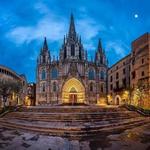
Gothic Quarter
The charming Gothic Quarter, or Barri Gòtic, has narrow medieval streets filled with trendy bars, clubs and Catalan restaurants. The Museu d'Història de Barcelona shows remains of the Roman city. Artisans sell leather and jewelry near the Cathedral of Barcelona, while flower stalls and street-food vendors line busy avenue La Rambla. The Plaça del Pi, named after the adjacent Gothic church, hosts a weekend art market.
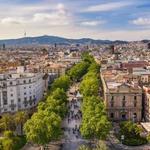
La Rambla
La Rambla is a street in central Barcelona. A tree-lined pedestrian street, it stretches for 1.2 km connecting the Plaça de Catalunya in its center with the Christopher Columbus Monument at Port Vell. La Rambla forms the boundary between the neighbourhoods of the Barri Gòtic to the east and the El Raval to the west. At La Rambla, you may see a lot of street vendors and the famous market La Boqueria. You can walk this street all the way to the beach!

Montjuïc Castle
Standing on a vantage point 173 metres above the port, Montjuïc Castle commands stunning views of the city. Now a peaceable place, the memory of this fortress endures in Barcelona as a symbol of repression but also of the city's struggles during different periods in its history. The top of Montjuïc is the ideal place for a bastion of defense, with 360º views of the city below. If you take the Teleferic del Port, it will drop you off on the hill that Castell de Montjuïc is built on.

MUHBA Turó de la Rovira (Mirador de les bateries)
This used to be an old bunker used by soilders during the Spanish Civil War. It is built on a hill overlooking Barcelona. It is a great place to have a picnic with up close city views. The best time to go is the afternoon to sunset when the sunlight lights the entire city. Taxis can take you up hill but a little hiking is still required. It gets pretty crowded but the view is well worth it.
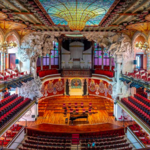
Palau de la Música Catalana
Although it is still a fully functioning music hall it is equally as popular as a tourist attraction with guided tours around an interior renowned for its distinctive and ornate style. Reviews report that this is a must see and feels as if you're in a giant Faberge Egg with beautiful stained glass windows. Remember to get your tickets online!
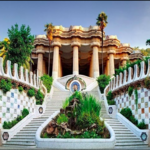
Park Güell
Park Güell is the reflection of Gaudí's naturalist phase (first decade of the 20th century). During this period, the architect perfected his personal style through inspiration from organic shapes. Another Barcelona must see. Get your tickets online!
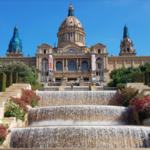
Plaça d'Espanya
Plaça d'Espanya is one of Barcelona's most important squares, built on the occasion of the 1929 Barcelona International Exposition, held at the foot of Montjuïc. You are first greeted by a huge roundabout and then two massive Venetian Towers. The square holds magical fountain shows in the summer. The Museu Nacional d'Art de Catalunya (MNAC) is at the very top of the square with great views of the city. Definitely a sight to see!
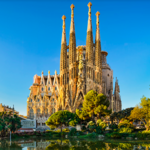
Sagrada Família
Designed by the Spanish architect Antoni Gaudí (1852–1926), his work on the building is part of a UNESCO World Heritage Site. This is a must see in Barcelona. The church was started in 1882 and projected to be finished after 2026. Gaudí himself passed away before the church's completion. The church's organic architecture is a marvel. Get tickets online to enter!

Telefèric del Port
Telefèric del Port is an aerial tramway in Barcelona, Catalonia, Spain. It crosses Port Vell, Barcelona's old harbour, connecting the Montjuïc hill with the seaside suburb of Barceloneta. Great way to get from the beach to the top of Montjuic. Great views of the city up close. Recommend going early to avoid long lines!
